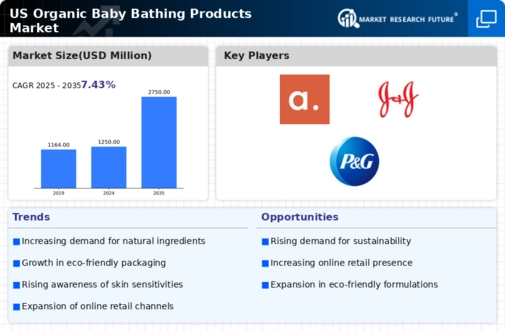The organic baby-bathing-product market is currently characterized by a dynamic competitive landscape, driven by increasing consumer demand for natural and safe products for infants. Key players such as The Honest Company (US), Burt's Bees (US), and Earth Mama (US) are strategically positioned to leverage this trend. The Honest Company (US) focuses on innovation and product diversification, continually expanding its range of organic offerings to meet evolving consumer preferences. Burt's Bees (US), with its strong brand heritage, emphasizes sustainability and ethical sourcing, which resonates well with environmentally conscious consumers. Earth Mama (US) adopts a holistic approach, integrating wellness into its product lines, thereby appealing to health-focused parents. Collectively, these strategies foster a competitive environment that prioritizes product integrity and consumer trust.
In terms of business tactics, companies are increasingly localizing manufacturing to enhance supply chain efficiency and reduce carbon footprints. This trend is particularly evident in the moderately fragmented market structure, where smaller brands are emerging alongside established players. The collective influence of these key players shapes market dynamics, as they compete not only on product quality but also on brand loyalty and consumer engagement.
In October 2025, The Honest Company (US) announced a partnership with a leading organic ingredient supplier to enhance its product formulations. This strategic move is significant as it underscores the company's commitment to sourcing high-quality, sustainable ingredients, which is likely to strengthen its market position and appeal to health-conscious consumers. By aligning with trusted suppliers, The Honest Company (US) may also improve its supply chain resilience, a critical factor in today’s market.
In September 2025, Burt's Bees (US) launched a new line of baby bathing products that are 100% biodegradable. This initiative not only reflects the company's dedication to sustainability but also positions it favorably among eco-conscious parents. The introduction of biodegradable products could potentially attract a new customer segment, enhancing brand loyalty and market share in a competitive landscape increasingly focused on environmental responsibility.
In August 2025, Earth Mama (US) expanded its distribution channels by entering into a collaboration with major online retailers. This strategic action is likely to enhance the brand's visibility and accessibility, catering to the growing trend of online shopping among parents. By leveraging e-commerce platforms, Earth Mama (US) may effectively reach a broader audience, thereby driving sales and reinforcing its market presence.
As of November 2025, current competitive trends in the organic baby-bathing-product market are heavily influenced by digitalization, sustainability, and the integration of AI technologies. Strategic alliances are becoming increasingly vital, as companies seek to enhance their product offerings and operational efficiencies. The shift from price-based competition to a focus on innovation, technology, and supply chain reliability is evident. Moving forward, competitive differentiation will likely hinge on the ability to innovate and adapt to consumer preferences, ensuring that brands not only meet but exceed expectations in quality and sustainability.














Leave a Comment